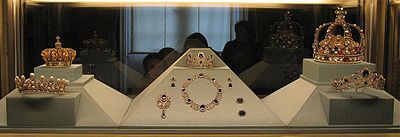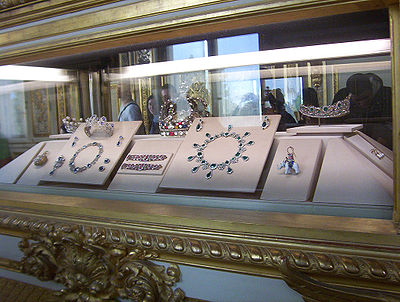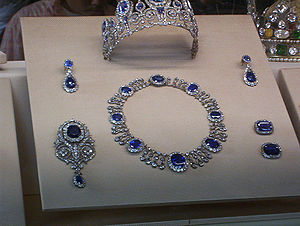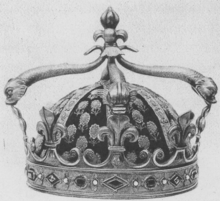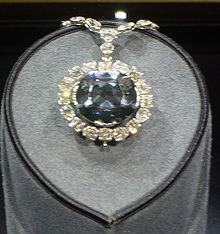- French Crown Jewels
-
The French Crown Jewels were the crowns, orb, sceptres, diadems and jewels that were the symbol of royalty and which were worn by many Kings and Queens of France. The set was finally broken up, with most of it sold off in 1885 by the Third French Republic. The surviving French Crown Jewels, principally a set of historic crowns now set with decorated glass, are on display in the Galerie d'Apollon of the Louvre, France's premier museum and former royal palace, together with the Regent Diamond, the Sancy Diamond and the 105-carat (21 g) Côte-de-Bretagne red spinel, carved into the form of a dragon. In addition, some gemstones and jewels (including the Emerald of Saint Louis, the 'Ruspoli' sapphire and the diamond pins of Queen Marie Antoinette) are on display in the Treasury vault of the Mineralogy gallery in the Muséum national d'histoire naturelle.
Use of the French crown jewels
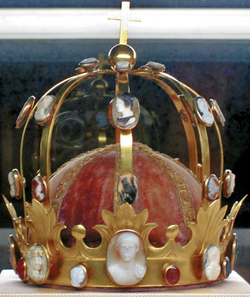 The Crown of Napoleon created in 1804. Louvre.
The Crown of Napoleon created in 1804. Louvre.
The Crown jewels comprise the instruments of the coronation called Regalia and the jewels of the ruling family.
Since Pepin the Short in 752, the accession of the King of France was legitimized by a coronation ceremony later performed with the Crown of Charlemagne at Notre-Dame de Reims called sacre, since the emphasis was on the unction with the chrism of the Holy Ampulla. All monarchs were crowned until the French revolution, in the Notre-Dame de Reims cathedral (apart for two of them, who were crowned elsewhere). After the revolution, only Emperor Napoleon I, Empress Josephine and King Charles X were crowned. Though not always used, a set of expensive crown jewels did exist and was augmented by various monarchs.
The Crown jewels or Diamants de la Couronne de France consisting of gemstones and jewellery[1] became unalienable by decision of Francis I on June 15, 1530. the Côte-de-Bretagne red spinel was then among the 8 main jewels. They suffered important loss by the Catholic League in 1590 but were reconstitued by Henry IV and greatly enhanced by Louis XIV notably with the gift of the 18 Mazarin diamonds and the buy of the 'Royal French Blue' and 'Ruspoli' sapphire later followed in 1717 with the Regent Diamond. Under Louis XV, they were kept in the Garde Meuble de la Couronne (Royal Treasury) in one of the pavilions of the Place de la Concorde where they suffered a theft in 1792 and a sale in 1795 after their partial recovery. In 1814, Napoleon I had restored the Crown jewels to 65 072 stones and pearls, not including the personal jewels of both empress Josephine and Marie-Louise. Enhanced again during the Restoration and more again during the Second Empire, they counted 77 662 stones and pearls comprising 51 403 brilliant cut diamonds, 21 119 rose cut diamonds, 2 962 pearls, 507 rubies, 136 sapphires, 250 emeralds, 528 turquoises, 22 opales, 235 amethysts and 500 other stones, when they were sold in 1885 by the Third Republic. Nevetheless, as in 1793, an important set of stones and pearls was sent to the Muséum national d'histoire naturelle and some of the most important jewels were bought back since 1953, what makes the collection still number more than 11 000 stones and pearls.[2]
The Regalia,[3] much lightly hit in 1590, were originally kept in the Basilica of Saint Denis[4] from where they were removed in 1793 during the French Revolution. Some few pieces, considered to present an artistic value, were preserved and sent to the Louvre and other parisians museums. The others, like the Crown of Charlemagne and the one of the Queens, were melted down or dismanteled, with the rest of the basilica treasure including the cross of Saint Eligius, the screen of Charlemagne or the gilded altar of Charles the Bald. The litugical instruments kept in Reims suffered the same policy. The Regalia were restored and recreated for the coronation of Napoleon I, which at their turn suffered again partial destruction in 1819, and finally completed for the coronation of Charles X in 1825.
Regalia and jewels at the Louvre
Crown of Louis XV
Of the about 20 documented royal crowns of the Ancien Régime,[5] the only surviving one from the destructions of 1590 and 1793 is the crown of Louis XV.[6] The king had the Regent Diamond set in the lower part of the fleur-de-lis in the front of his crown, while eight of the famous Mazarin diamonds that the cardinal had bequeath to the French Crown are set in the other seven fleur-de-lis and in the circlet of the crown. Diamonds and colored gemstones are set between two rows of pearls on the circlet and are also set into the four arches that rise behind the fleur-de-lis and the eight ornamental points between the fleur-de-lis. At the junction of these four arches is a small pedestal surrounded by two rows of small diamonds on either side of a row of small pearls. Eight larger diamonds set between this pedestal and the arches give the effect of a sunburst when the crown is viewed from above. On the pedestal rises a double fleur-de-lis formed of nine large diamonds, including the Sancy Diamond which forms the central upper petal of this double fleur-de-lis. The gold brocade cap which lines the crown is also ornamented with large diamonds.
Since the Middle Ages, and previous to the making of this crown, the crowns of French kings were adorned with gemstones like the Crown of Charlemagne or the crown of Saint Louis sometimes called Sainte Couronne.[7] But some of the most valuable precious stones could be removed of them, since it was traditional for a French king to bequeath his crown to the treasury of the Abbey, now Basilica of St Denis on their deaths. This crown was also bequeath to Saint Denis on the death of Louis XV, but not before the diamonds had been replaced with crystals and it is on display presently in the Louvre similarly set with crystals.
Crown of Napoleon I
The Crown of Napoleon was made by the jeweller Martin-Guillaume Biennais with antique cameos for the coronation of the Emperor in 1804. His gilded crown of laurels[8] was destroyed in 1819 by Louis XVIII with the one of Empress Josephine, the orb and the eagle sceptre. His coronation throne is at the Louvre[9] and the coronation ring of Empress Josephine at the Château de Malmaison.
Crown of Empress Eugenie
The Crown of Empress Eugenie was created in 1855 by Gabriel Lemonnier for the World's fair, like the one of the Emperor which was destroyed in 1887.[10] But Napoleon III finally chose not to be crowned.[11] Her diadem and large corsage diamond knot by the same jeweller are as well presented in the Louvre with a large diamond brooch by Alfred Bapst bearing two big Mazarin stones.
Coronation sword
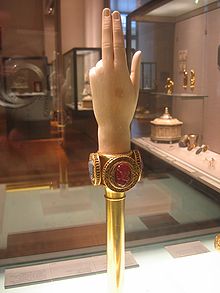 The recreated "Hand of Justice". Louvre.
The recreated "Hand of Justice". Louvre.
 "Throne of Dagobert", traditionally attributed to Dagobert I, while the arms and the back of the chair were added under Charles the Bald. Cabinet des Medailles.
"Throne of Dagobert", traditionally attributed to Dagobert I, while the arms and the back of the chair were added under Charles the Bald. Cabinet des Medailles.
The sword used during the coronation of the kings of France is displayed at the Louvre museum with its 13th century sheath,[12] apart from the crown jewels. In the first part of the celebration, the king received the insignia of knighthood, consisting of spurs and the sword. Throughout the rest of the ceremony, the sword was entrusted to the "Connétable", who held it with the blade pointing upwards. The treasury of Saint-Denis possessed several medieval swords including the one of Saint Louis. According to legend the coronation sword is "Joyeuse", [33] Charlemagne's sword.[13] Its unusual build and ornamentation make it difficult to date, but the parts probably date to the 10th to 13th century. Some believe it might be much older, even manufactured before Charlemagne's reign.
The coronation swords of Napoleon I and Charles X also were preserved in the Louvre museum, although the first was transferred to the Palace of Fontainebleau with most of the preserved litugical instruments and robes of the imperial ceremony and the latter stolen in 1976.
Coronation spurs
Some elements of the 12-16th centuries spurs were partially replaced for the coronation of Napoleon I.[14]
Sceptre of Charles V
One of the few surviving pieces of the medieval French crown jewels is the Sceptre Charles V had made for the future coronation of his son, Charles VI, currently on display in the Louvre.[15] It is over five feet long and at the top is a lily supporting a small statuette of Charlemagne.[16] This evocation of Charlemagne may also explain why this sceptre was included in the imperial regalia of Napoleon I.[17]
The sceptre of Dagobert I was stolen in 1795 during the Revolution.
Main de Justice
A uniquely French type of sceptre is the Main de Justice (Hand of Justice), which has as its finial an ivory Hand of God in a blessing gesture.[18] Only the ivory finial itself appears to be medieval and probably comes from one of the three former Hands of Justice in the treasure of Saint Denis, perhaps the one of Saint Louis. The present golden rod which it terminates was probably made for either the coronation of Napoleon I [34] or that of Charles X.[35] The addition of cameos and other medieval gemstones like the XIIth century ring of Saint Denis which surround the junction of the finial and the replaced rod represent a deliberate nineteenth century anachronism.[19]
Another sceptre, the Baton of Guillaume de Roquemont,[20] and the ring of Saint Louis[21] are at the Louvre.
Brooch of Saint Louis
The collection keeps as well the 14th century brooch or fermail of Saint Louis, a large diamond shaped fibula bearing a fleur-de-lis in precious stones, which was used to hold the coronation's robe.[22]
Serpentine paten
The serpentine paten said of Abbot Suger of 1st century B.C. or A.D. associated with the Cup of the Ptolemies was used at the coronation of queens and keeps its gem-studded gold Carolingian mountings of Charles the Bald.[23]
Famous diamonds
Among the most famous diamonds[24] preserved in the collection and now kept in the Apollo Gallery of the Louvre are the Sancy Diamond, which once had been part of the pre-Commonwealth Crown Jewels of England, the Hortensia pink diamond cutted in 1678 for Louis XIV and above all the Regent Diamond.[25] The treatment of the Regent Diamond epitomised the attitude of the French Royal Family to the Crown Jewels. While the Regent Diamond was the centrepiece of the King Louis XV crown, and worn by him at his coronation in February 1723, Marie Antoinette, wife of Louis XVI, wore it in a black velvet hat. The Royal French Blue was transformed into the Hope Diamond now in the Smithsonian Institution in Washington, D.C..
With two remaining jewels of the Renaissance, the Côte-de-Bretagne red spinel and the Dragon perle, a pin shaped into the form of a delphin, The crown jewels collection contains as well among others, the emerald set and pearl earings of Empress Josephine, the micromosaic and emerald and diamond sets of Empress Marie Louise, the pair of bracelets of rubies and the emerald diadem of the Duchess of Angoulème, the sapphire set of Queen Marie Amélie, a diamond cross of the Order of the Holy Spirit or a diamond portrait box of Louis XIV.[26][27]
Gemstones in the Natural history museum and Ecole des Mines
Some gemstones and jewels are on display in the Treasury vault of the Mineralogy gallery in the Muséum national d'histoire naturelle. They include the 51.60-carat (10.32 g) Emerald of Saint Louis,[28] the 135.80-carat (27.16 g) 'Ruspoli' sapphire,[29] the Topaze (28.10 carats) and great Emerald (17 carats) of Louis XIV, the diamond pins of Queen Marie Antoinette, the Diamond-portrait (9.10 carats) and the Amethyst of Empress Marie Louise, the great Opale of Louis XVIII, the bicolore Sapphire (19.67 carats), the Jonquille diamond (9.75 carats) and more than 800 pearls and stones. Furthermore a set of 1 044 stones and pearls is kept at the Ecole des Mines in Paris.
Regalia in the National Library of France
The Throne of Dagobert I coming from Saint Denis can now be seen on the Richelieu site of the National Library of France. The Cup of the Ptolemies was used by the queens to take ablution after holy communion. This masterpieces among hardstone carvings or engraved gems of Antiquity,[30] was carved with Dionysiac vignettes and emblems, probably in Alexandria during the first century BC or the first century after. It was stolen in 1804, and recovered without its Carolingian gem-studded gold mountings. Its serpentine paten is at the Louvre.
Charles X Regalia in Saint Denis
Some of the sovereign's robes of the coronation of Charles X and regalia specially made for this event including the Crown of Charles X and the Crown of Queen Marie Thérèse of Savoy are displayed in one of the chapels of the nave of the Basilica of Saint Denis.[31] The Crown of the Dauphin Louis Antoine Duke of Angoulême which subsists as well counts too among the six only surviving French crowns.
Liturgical instruments and robes in Reims
The Holy Ampulla reconstituted with some recovered fragments of the original balm for the coronation of Charles X[32][33] in 1825, which was originally kept in the Abbey of Saint-Remi, is now presented in the Palace of Tau next to the cathedral Notre-Dame de Reims with the coronation Chalice as well as several preserved sovereign's robes and gowns of kings of the Ancien Regime and the liturgical instruments made for the coronation of Charles X. They are displayed with the few remaining pieces of the medieval treasure of the cathedral and the Talisman of Charlemagne, a large sapphire said to have been given by the Caliph Harun al-Rashid which was found in the Emperor's grave in 1804 and later offered by Empress Eugenie. Since 1906, the content of the Holy Ampulla is kept in Reims archbishopric.[34]
Theft of the crown jewels during the revolution
The Hope Diamond, which was cut from the Royal French Blue, part of the French Crown Jewels.
The Crown Jewels were stolen in 1792 when the Garde Meuble (Royal Treasury) was stormed by rioters. Most, though not all, of the Crown Jewels were recovered eventually. Neither the Sancy Diamond nor the French Blue Diamond were found in the years after, however. The Royal French Blue is believed to have been recut, and it is now known as the Hope Diamond.
The Hope is famously alleged to have been surrounded by bad luck. Marie Antoinette who supposedly wore it was beheaded (in fact, it was actually worn by her husband, Louis XVI, although he too was beheaded). Other owners and their families experienced suicides, marriage break-ups, bankruptcy, deaths in car crashes, falls off cliffs, revolutions, mental breakdowns, and deaths through drug overdoses. It was even tangentially associated with the case of the murdered Lindbergh baby, when its then owner, silver heiress Evalyn Walsh McLean, pawned it to raise money that she ended up paying to a con-man unconnected with the actual kidnapping. Most modern historians view the tales of a curse on the Hope to be spurious; the first mention of such tales is documented to 1908. Pierre Cartier, the Parisian jeweler, is widely credited with publicizing the stories of a curse on the diamond in hopes of increasing its saleability. Since 1958, it has been in the Smithsonian Institution in Washington, D.C., where it is the single most-viewed object in the Smithsonian's collection.
The Crown Jewels were augmented by jewels added by Napoleon I and Napoleon III along with their empresses.
Last coronation
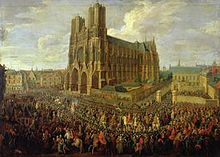 Procession of Louis XV of France after his coronation in Notre-Dame de Reims, traditional location of the coronations of Kings of France
Procession of Louis XV of France after his coronation in Notre-Dame de Reims, traditional location of the coronations of Kings of France
The last French coronation occurred in 1825 when King Charles X was crowned at Reims. The scale of the coronation was seen by critics to indicate a return to the absolutism of the ancien regime that had been ended by the Revolution of 1789.Some historians suggest that the very grandeur of the ceremony marked the beginning of the end for the Bourbon monarchy, with Charles's image as an old style monarch falling out of favour with the French public, who had much preferred the low-key monarchy of his brother, Louis XVIII. Louis Phillipe of France, the last King of France, was not crowned, and neither was Napoleon III, the last Emperor. Napoleon III's consort, Eugénie de Montijo, did have a crown made for her, though it was never used in an official coronation.
Break-up and sale of the French crown jewels
Throughout the late eighteenth and nineteenth centuries the jewels survived the First French Republic, the Directorate, the First Empire, the Restoration, the July Monarchy, the Second French Republic and the Second Empire. However, the decision of Henri, Comte de Chambord not to accept the French Crown in the early 1870s ended not just the prospect of a royal restoration. It also led to the break-up and partial sale of the Crown Jewels. The Brazilian Beauty Symbol Aimee de Heeren,[35] mistress of President Getulio Vargas is known for being the largest private owner of the French Crown jewels, along with the Brazilian crown jewels and other important jewelry.
In 1875 the Third French Republic came into being with the passage of a series of Organic Laws (collectively forming a constitution). The interim presidency was replaced by a full "President of the Republic".
While few expected a royal restoration, certainly after the failure of the Seize Mai attempted royalist coup by President Patrice MacMahon, duc de Magenta, the continuing agitation of extreme right wing royalists, and the fear of a royalist coup d'état, led radical deputies to propose the sale of the Crown Jewels, in the hope that their dispersal would undermine the royalist cause: "Without a crown, no need for a king" in the words of one member of the National Assembly. This controversial decision was implemented. All the jewels from the Crown Jewels were removed and sold in 1887, as were many of the crowns, diadems, rings and other items. Only a few of the crowns were kept for historic reasons, but with their original diamonds and gems replaced by colored glass. Some historic or unusual gems went to French museums, including the corsage brooch containing some of the 'Mazarin diamonds'[36], which is now in the Louvre, and the 'Ruspoli' sapphire, which is now in the French Natural History Museum (curators took advantage of its unusual rhombohedral faceted shape and asked for it to be exempted from the sale, falsely claiming that it was a natural, uncut crystal).
Most recent royal ceremony in France: The funeral of Louis XVII in 2004
One of the mysteries of the French Revolution was the question of what had happened to the Dauphin, the heir apparent of King Louis XVI, after the execution of the King and Queen. Though it was generally believed that he had died in prison, popular legend had spoken of the young prince being spirited away from his prison and living in exile.
In 2004, however it was finally confirmed that the legend was fictitious. In reality Louis XVI's son, Louis Charles, called the young prince by some, and King Louis XVII of France by royalist supporters following his father's death, had died of tuberculosis in prison. The fact of his death was established using DNA evidence. The heart of the young man claimed by the royalists to be the young Louis XVII had been secretly removed by a doctor just after his death. By comparing the DNA from the heart with DNA taken from strands of hair of Marie Antoinette that had been kept as a memento by royalists, it was possible to establish that the boy who died in prison was indeed the son of Louis XVI and Marie Antoinette; the above mentioned heir to the crown of Louis XVI.
The formal funeral for Louis XVII finally took place, albeit with his heart, not his body, in 2004. For the first time in over a century a royal ceremony took place in France, complete with the fleur-de-lis standard and a royal crown.
References
- ^ [1] List of the surviving main Crown jewels
- ^ [2] History of the Diamants de la Couronne
- ^ [3] List of the surviving Regalia
- ^ [4] Plates of the treasure from Dom Michel Félibien, Histoire de L'Abbaye Royale de Saint-Denys en France, 1706
- ^ [5] The royal crowns in the treasure of Saint Denis in 1706, from Dom Michel Félibien, Histoire de L'Abbaye Royale de Saint-Denys en France
- ^ [6] Crown of Louis XV, 1722, Louvre
- ^ [7] Crown of Saint Louis.
- ^ [8] Napoleon I in coronation costume, François Gérard, 1805, Louvre
- ^ [9] Throne of Napoleon I, 1804, Louvre
- ^ [10] Crown of Empress Eugenie, 1855, Louvre
- ^ [11] Portrait of Napoleon III with his crown, ca 1855, Louvre
- ^ [12] King's sword sheath, 13th c., Louvre
- ^ [13] Coronation sword, 10-13th c., Louvre
- ^ [14] Coronation spurs, 12-16th c. and 1804, Louvre
- ^ [15] Sceptre of Charles V, 14th c., Louvre
- ^ [16] Sceptre of Charles V
- ^ File:Ingres, Napoleon on his Imperial throne.jpg
- ^ [17] Hand of Justice, 1804 and medieval, Louvre
- ^ [18] Ring of Saint Denis, 12th c., Louvre
- ^ [19] Baton of Guillaume de Roquemont, 14th c., Louvre
- ^ [20] Ring of Saint Louis, 14th c., Louvre
- ^ [21] Brooch (fermail) of Saint Louis, 14th c., Louvre
- ^ [22] Serpentine paten, 1st century B.C. or A.D and 9th c., Louvre
- ^ [23] The Diamants de la Couronne
- ^ [24] Regent Diamond, Louvre
- ^ [25] List of the surviving main Crown jewels
- ^ [26] The jewels in the Apollo gallery, Louvre
- ^ [27] Emerald of Saint Louis, Museum national d'histoire naturelle
- ^ [28] 'Ruspoli' sapphire, Museum national d'histoire naturelle
- ^ Cup of the Ptolemies, "the most precious vase that is in the treasure of Saint-Denis, and perhaps in any European cabinet." (Michel Félibien, Histoire de... Saint-Denys, Paris, 1706, pl. vi, at full scale); "one of the greatest treasures in the Cabinet des Médailles" (Sir W. Martin Conway, 1915, pp 119f (on-line); etc.
- ^ [29] The regalia of Charles X and Queen Marie Thérèse of Savoy in the Basilica of St Denis
- ^ [30] Reliquary of Charles X for the Holy Ampulla
- ^ [31] Ampulla and needle of the reliquary of Charles X
- ^ [32] Content of the Holy Ampulla kept in Reims archbishopric.
- ^ Aimee de Heeren, later owner of the private jewelry of Empress Eugenie
Crown jewels by country Austria · Brazil · Czech Republic · Denmark · France · Germany (Bavaria · Prussia) · Greece · Hungary · Holy Roman Empire · Iran · Ireland · Japan · Malaysia · Madagascar · Netherlands · Nigeria · Norway · Poland · Romania · Russia · Serbia · Spain · Sweden · Thailand · United Kingdom (Scotland · Wales)Former or historical sovereign states shown in italicsCategories:- House of Bonaparte
- Crown jewels
- Crowns
- French monarchy
- History of Paris
Wikimedia Foundation. 2010.

